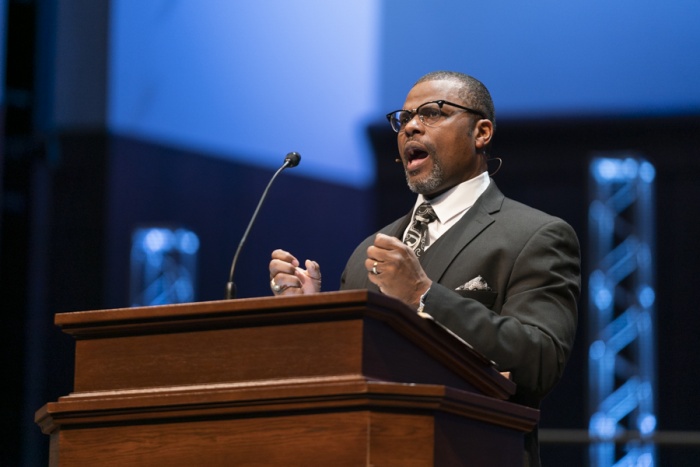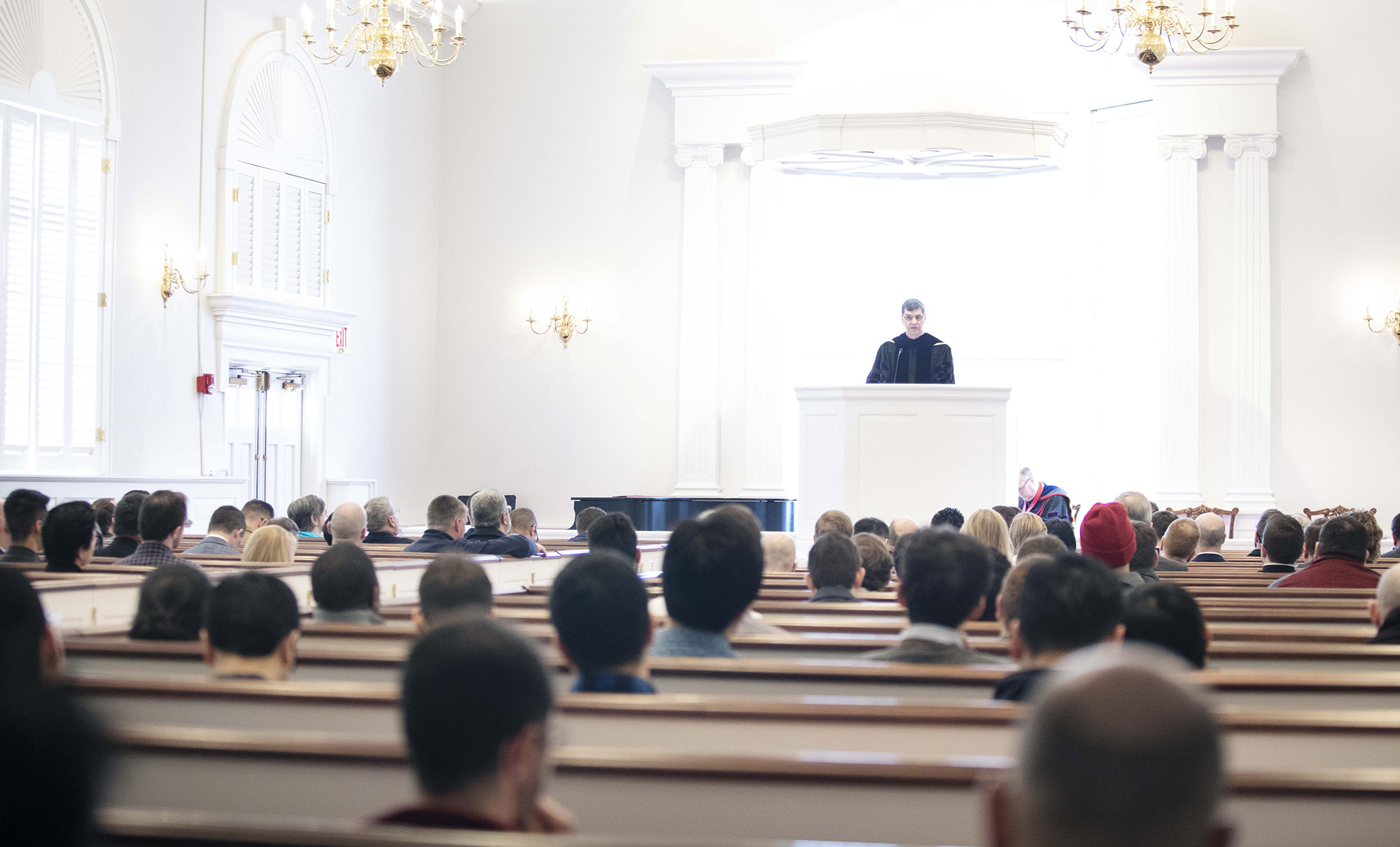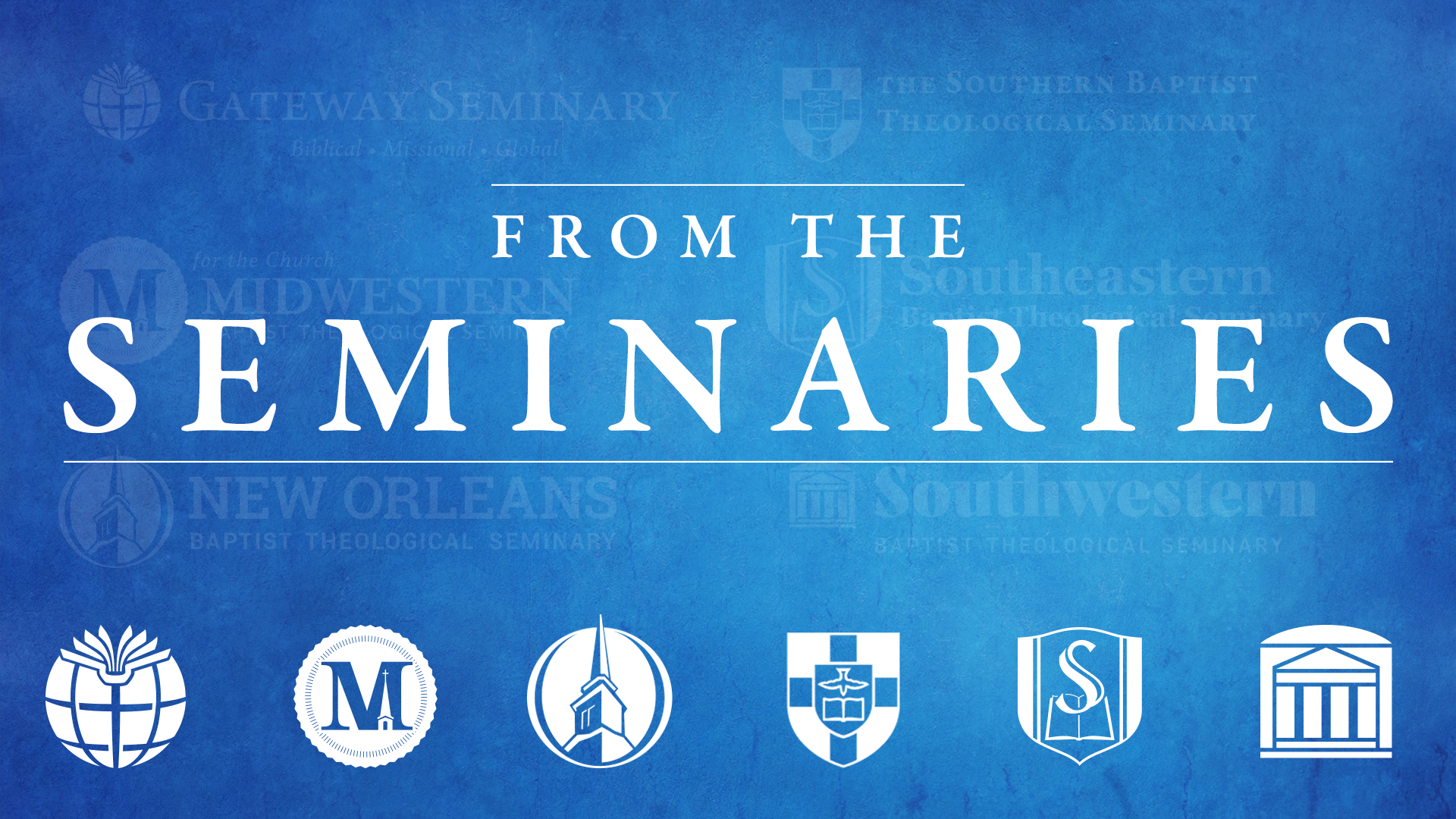
BGCT president encourages Southwestern students to ‘move forward with victory in mind’; SBTS professor: ‘Allusive patterns’ fundamental to understanding of biblical theology.
BGCT president encourages Southwestern students to ‘move forward with victory in mind’
By Alex Sibley
FORT WORTH, Texas (BP) — “Move forward with victory in mind” was the exhortation of Michael Evans, president of the Baptist General Convention of Texas (BGCT), during his chapel address at the Southwestern Baptist Theological Seminary Feb. 20. Preaching from Deuteronomy 20:1-4, wherein God assures the Israelites of their future victory in the Promised Land, Evans encouraged his listeners to face the world today with the same assurance.
During his sermon, Evans, senior pastor of Bethlehem Baptist Church in Mansfield, Texas, recalled a recent conversation he had with a student at another seminary. The student asked him, “In this time of chaos and confusion and division, what would you say to us seminarians who are in such despair as it concerns spreading the Gospel?”
 Evans smiled and replied, “Are you kidding me? This is our time. We are uniquely placed to boldly go before men and women and to proclaim the Gospel of our Lord and Savior Jesus Christ. Perk up. Get ready. Put your armor on. Because it is time to go and fight the good fight of faith.”
Evans smiled and replied, “Are you kidding me? This is our time. We are uniquely placed to boldly go before men and women and to proclaim the Gospel of our Lord and Savior Jesus Christ. Perk up. Get ready. Put your armor on. Because it is time to go and fight the good fight of faith.”
Addressing the chapel audience, Evans said, “Those of us who have been called to serve our Lord and Savior Jesus Christ, you need to get your armor ready, because we are going out to war.”
Evans said that Christians today are called to “compassionately confront the world.”
“If we keep silent in the face of injustice, we then become complacent,” he said. “If we keep silent in the midst of immoral behavior, we then lose our moral direction. If we keep silent and fail to establish rules in our families, our relationships will rot, our communities will crumble, our churches will become meaningless meeting places and mere museums. … We dare confront the world.”
Such confrontation, Evans explained, means first and foremost seeing all human beings as “prospects for salvation.” He further encouraged the chapel audience to live by faith, not by sight, which he termed as living with a “sanctified mind.”
“A sanctified mind is a transformed mind,” he said. “You rebuke negative opinions of yourself when you have a sanctified mind. Self-criticism is not what defines you. Failure does not defeat you.
“… There ought to be people in here who can say, ‘Because of the experience that I’ve had with God myself, when I found myself in impossible situations and in impossible places, all I know is that my God can make a way.'”
Evans concluded that God “goes with you to fight for you against your enemies to give you the victory.”
“He’s not there just to hold your hand,” Evans said. “He’s not there just to be your big buddy. He is there to help you to conquer whatever it is you’re dealing with in your daily lives. … Whatever it is that you need God to do on your behalf, if He’s assigned you to it, it may look tough, but it’s already done.”
“How do you know?” Evans asked. “… He fixed it on a hill called Calvary on an old, rugged cross, when they put nails in His hands and rivets in His feet. He died for us. There’s mighty good news in that, because when He died for us, in that was our salvation. And then early Sunday morning, when He got up with all power of heaven and earth in His hands, we were able to inherit that power — overcoming power, making-it-through power, salvific power, deliverance power.”
“Ladies and gentlemen,” he said, “move forward with victory on your mind.”
**********
SBTS professor: ‘Allusive patterns’ fundamental to understanding of biblical theology
By Forrest Strickland
LOUISVILLE, Ky. (BP) — Biblical authors often allude to previous moments in the biblical storyline to help readers better understand theological themes, argued professor Duane A. Garrett during a faculty lecture at the Southern Baptist Theological Seminary Feb. 19. The lecture, titled “Elijah at Sinai,” was delivered in the historic Broadus Chapel.
 Garrett, the John R. Sampey Professor of Old Testament Interpretation and Professor of Biblical Theology, argued that these “allusive patterns” consist of references to previous passages of Scripture that help make clear what the biblical author wants the reader to learn.
Garrett, the John R. Sampey Professor of Old Testament Interpretation and Professor of Biblical Theology, argued that these “allusive patterns” consist of references to previous passages of Scripture that help make clear what the biblical author wants the reader to learn.
Garrett took as his theme 1 Kings 19, in which the prophet Elijah fled to Mount Sinai to escape from the wrath of Jezebel, leading to Elijah’s complaint against the faithlessness of Israel. Though Elijah had just witnessed fire come down from heaven and consume the burnt offering, reaffirming the Lord as the true God, Elijah was despondent over the Israelites’ faithlessness when he reached Sinai, and he sought to prosecute them before God. The author of 1 Kings includes details that remind the reader of Moses’ intercession for Israel while he was on Mount Sinai in Exodus 19, Garrett argued.
“Moses is the paradigm,” Garrett said. “His intercession demonstrates that, for all his frustration and disappointment, the true prophet of God must plead for Yahweh’s people and not against them. Elijah, in this regard, failed to live up to the paradigm.”
“The essential message of the Moses-Elijah parallel in 1 Kings 19 is unambiguous. The prophet of God should intercede for sinners and not seek their destruction.”
Later biblical authors connect the theme of the ideal prophet from Moses at Sinai in Exodus 19 and later Elijah at Sinai in 1 Kings 19 to their own writings, Garrett argued. This is most clear in the book of Jonah. Like Elijah, Jonah failed to live up to the standard of an ideal prophet established in the example of Moses in Exodus 19.
“Jonah’s yearning to see Nineveh destroyed has an obvious parallel in Elijah’s prosecution of Israel. Therefore by means of the allusions to Moses and Elijah, the book of Jonah extends the reader’s understanding of the compassion of Yahweh and the role of the prophet. Jonah rejected Moses’ model of intercessor and embraced Elijah’s model of prosecutor.”
Though Elijah and Jonah serve as negative examples, these passages help illuminate passages in the New Testament. The theme of the true prophet is taken up by the Gospel writers, who link the narratives of Moses, Elijah, and Jonah, and demonstrate how Jesus is the fulfillment of the ideal prophet envisioned throughout the Old Testament.
“When the account of the transfiguration of Jesus alludes to the complex of stories involving Moses, Elijah, and Jonah, it does not saddle those passages with alien ideals but taps into an already existing allusive pattern. And, the allusions are not casual literary parallels, curiosities of no real significance. The allusions imply that Jesus is bringing the theological ideal of the Old Testament prophet to its culmination,” Garrett said.
“The Gospel narratives complete what the Old Testament had begun. Jesus is the final manifestation of the ideal of a prophet. The New Testament narrative is coherent with the Old, and it carries the Old Testament to its final denouement.”
Gospel writers point the reader to the heart of a passage through the use of allusions to the Old Testament. These New Testament allusions provide the final resolution, denouement, to Old Testament themes, Garrett argued. Though the transfiguration is deeply meaningful as a stand-alone passage, Garrett said, when seen from the perspective of the biblical storyline, the significance of the transfiguration of Jesus is made even more clear.
“In the New Testament, the narrative of the transfiguration of Jesus draws upon the Moses-Elijah-Jonah pattern,” Garrett said. “But what is the significance of Jesus’ transfiguration? We might simply answer that Jesus was glorified and so He was. But the allusions imply that the glory here is something specific: It is the same as the glory that made Moses’ face shine, it is the quiet voice that rebuked Elijah. It is the revelation that God is gracious and compassionate.”
“The servant of Yahweh seeks forgiveness of sinners and not their destruction, thus the light that shone from Jesus revealed Him to be the great intercessor, filled with the same grace that was reflected in Moses’ shining face. The fundamental issue in the divine encounters of Moses, Elijah and Jonah is how the servant of God will respond to sinners.”
Garrett has served on faculty at Southern Seminary for 16 years, and his published works include Song of Songs, in the Word Biblical Commentary series; A Modern Grammar for Classical Hebrew; Angels and the New Spirituality; Authority and Interpretation; and Hosea and Joel in the New American Commentary series. He also serves as the general editor for “The Archaeology Study Bible” from Zondervan Press.
Garrett has also served on the faculty of Gordon-Conwell Theological Seminary, Bethel Seminary, Canadian Southern Baptist Seminary, Mid-America Baptist Seminary and Korea Baptist Seminary.
Garrett earned his master of divinity from Trinity Evangelical Divinity School, in Deerfield, Ill., and his doctor of philosophy from Baylor University, in Waco, Texas.
Audio and video of the lectures will be available soon on Southern Equip.
















